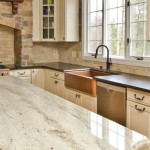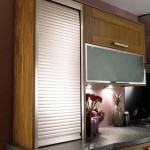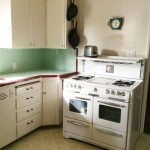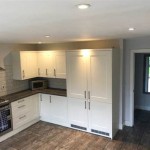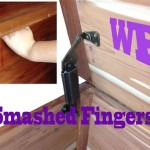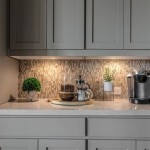Kitchen Cabinet Detail CAD Block: A Comprehensive Guide
The creation of detailed and accurate kitchen designs necessitates the use of Computer-Aided Design (CAD) blocks. These digital assets represent standardized components, allowing designers and architects to efficiently plan and visualize kitchen spaces. Specifically, kitchen cabinet detail CAD blocks are essential for showcasing the intricacies of cabinet construction, hardware, and overall aesthetic within the design. This article examines the significance, types, application, and considerations involved in utilizing kitchen cabinet detail CAD blocks.
CAD blocks, in essence, are pre-drawn objects or symbols that can be seamlessly inserted into CAD drawings. This eliminates the need to repeatedly draw common elements, saving considerable time and effort. Kitchen cabinet detail CAD blocks encompass a wide range of representations, from simple rectangular shapes depicting cabinet outlines to highly detailed depictions of door styles, drawer fronts, hinges, and internal shelving. Such blocks are critical for communicating design intent to contractors, manufacturers, and clients.
The use of these blocks extends beyond mere aesthetic representation. They play a crucial role in ensuring accurate measurements, identifying potential clashes between components, and generating precise material lists for construction. A well-developed library of kitchen cabinet detail CAD blocks is an invaluable resource for any professional involved in kitchen design or renovation.
Understanding the Importance of Detailed CAD Blocks
The primary reason for employing detailed CAD blocks in kitchen design lies in the accuracy and clarity they provide. Unlike simplified representations, detailed blocks incorporate crucial dimensional information, including overall cabinet height, width, and depth, as well as the precise placement of hardware elements. This level of detail minimizes the potential for errors during the construction phase, preventing costly rework and ensuring a seamless installation process.
Another key benefit of detailed CAD blocks is their ability to visually communicate design concepts effectively. Clients can readily understand the intended look and feel of their new kitchen through realistic depictions of cabinet styles, finishes, and hardware. This visual clarity streamlines the decision-making process and reduces the likelihood of misinterpretations or dissatisfaction with the final result.
Furthermore, these blocks facilitate collaboration between different stakeholders in the project. Architects, designers, contractors, and manufacturers can all work from a shared set of CAD files, ensuring that everyone is on the same page regarding the design specifications. This coordinated approach minimizes the risk of communication breakdowns and promotes a more efficient workflow.
Detailed CAD blocks also contribute significantly to the creation of accurate material lists and cost estimates. By incorporating information about the materials used in each cabinet component, these blocks enable designers to quickly generate a comprehensive list of required materials, along with their respective quantities. This information is essential for obtaining accurate quotes from suppliers and managing the budget effectively.
Types of Kitchen Cabinet Detail CAD Blocks
Kitchen cabinet detail CAD blocks can be categorized based on several factors, including cabinet type, door style, and level of detail. Understanding these different categories is crucial for selecting the appropriate blocks for a specific project.
Based on cabinet type, common categories include base cabinets, wall cabinets, tall cabinets, and specialty cabinets (e.g., corner cabinets, pantry cabinets). Each of these categories requires its own set of CAD blocks to accurately represent its unique dimensions and features. Base cabinets, for example, will typically include details related to toe kicks, adjustable legs, and internal shelving, while wall cabinets will focus on mounting hardware and internal lighting.
Door style is another important factor to consider. Common door styles include shaker, slab, raised panel, and glass-front. Each of these styles requires a unique CAD block to accurately depict its distinctive appearance. The complexity of the block will vary depending on the intricacy of the door style. For instance, a raised panel door will require more detailed modeling than a simple slab door.
The level of detail in a CAD block can range from simple 2D representations to highly detailed 3D models. Simple 2D blocks are often used for schematic design and preliminary layouts, while detailed 3D models are preferred for visualization and construction documentation. The choice between 2D and 3D blocks will depend on the specific needs of the project and the available resources.
Finally, CAD blocks can also be categorized by manufacturer. Many cabinet manufacturers provide their own libraries of CAD blocks, which accurately represent their specific product lines. Using manufacturer-specific blocks ensures that the design is compatible with the available cabinet options and simplifies the ordering process.
Application and Considerations When Using CAD Blocks
The effective application of kitchen cabinet detail CAD blocks requires a systematic approach and careful consideration of several factors. Before starting a project, it is essential to establish a well-organized library of CAD blocks, categorized by cabinet type, door style, and manufacturer. This will facilitate the process of selecting the appropriate blocks for each element of the design.
When inserting CAD blocks into a drawing, it is crucial to ensure that they are properly scaled and aligned. Incorrectly scaled or aligned blocks can lead to significant errors in the final design. It is also important to pay attention to the layer assignments of the blocks, ensuring that they are placed on the appropriate layers for visibility and organization.
Another important consideration is the level of detail required for each element of the design. While detailed CAD blocks are generally preferred, they can also increase the file size and complexity of the drawing. It is important to strike a balance between accuracy and efficiency, using the appropriate level of detail for each element of the design.
Furthermore, designers should be aware of the limitations of CAD blocks. While they can accurately represent the dimensions and appearance of cabinet components, they may not capture all of the nuances of real-world construction. It is important to supplement CAD drawings with detailed specifications and shop drawings to ensure that the final product meets the required standards.
Regularly updating the CAD block library is also essential. As cabinet manufacturers introduce new products and styles, it is important to update the library with the latest versions of the blocks. This will ensure that the designs accurately reflect the available options and prevent potential compatibility issues.
The use of dynamic CAD blocks can also enhance the efficiency of the design process. Dynamic blocks allow users to modify certain parameters, such as cabinet width or height, without having to redraw the entire block. This can save considerable time and effort, especially when dealing with complex or customized designs.
The implementation of CAD standards and best practices is paramount. Standardizing the use of layers, line weights, and text styles ensures consistency and clarity across all drawings. This is particularly important when collaborating with multiple designers or contractors.
Finally, proper training and education are essential for effectively utilizing kitchen cabinet detail CAD blocks. Designers should be familiar with the features and functionalities of the CAD software, as well as the principles of kitchen design and construction. This will enable them to create accurate, efficient, and visually appealing kitchen designs.
In conclusion, kitchen cabinet detail CAD blocks are indispensable tools for creating accurate, efficient, and visually appealing kitchen designs. By understanding the importance of detailed blocks, the different types available, and the considerations involved in their application, designers can leverage these tools to streamline the design process, minimize errors, and ensure client satisfaction. A comprehensive understanding of these digital assets is crucial for success in the field of kitchen design and renovation.

Able Cabinet And Countertops Dovetail Designs Millwork

Cad Detail Of Kitchen Dwg Free Blocks

Kitchen Cabinet Section Detail Drawing In Autocad File

Cad Detail Drawing Of Kitchen Cabinets By Dashawn Wilson At Coroflot Com

Kitchen Cabinet Detail Dwg For Autocad Designs Cad

2d Cad Drawing Kitchen Cabinet Construction Design Autocad File

Modern Kitchen Cabinet Section Detail Dwg Autocad Drawing

Cad Corner Free Autocad Blocks Hatch Patterns Lisp And Text Styles

Various Kitchen Cabinet Autocad Blocks Elevation V 2 All Kinds Of Cad Drawings Bundle Design Free Details

Kitchen Furniture Detail Cad Blocks 2d View Autocad File
Related Posts


